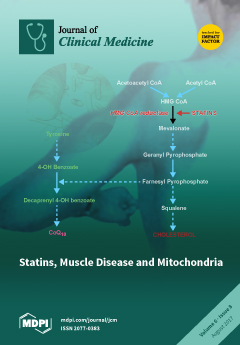Open AccessFeature PaperArticle
Use of FGF-21 as a Biomarker of Mitochondrial Disease in Clinical Practice
by
Alireza Morovat, Gayani Weerasinghe, Victoria Nesbitt, Monika Hofer, Thomas Agnew, Geralrine Quaghebeur, Kate Sergeant, Carl Fratter, Nishan Guha, Mehdi Mirzazadeh and Joanna Poulton
Cited by 53 | Viewed by 6416
Abstract
Recent work has suggested that fibroblast growth factor-21 (FGF-21) is a useful biomarker of mitochondrial disease (MD). We routinely measured FGF-21 levels on patients who were investigated at our centre for MD and evaluated its diagnostic performance based on detailed genetic and other
[...] Read more.
Recent work has suggested that fibroblast growth factor-21 (FGF-21) is a useful biomarker of mitochondrial disease (MD). We routinely measured FGF-21 levels on patients who were investigated at our centre for MD and evaluated its diagnostic performance based on detailed genetic and other laboratory findings. Patients’ FGF-21 results were assessed by the use of age-adjusted
z-scores based on normalised FGF-21 values from a healthy population. One hundred and fifty five patients were investigated. One hundred and four of these patients had molecular evidence for MD, 27 were deemed to have disorders other than MD (non-MD), and 24 had possible MD. Patients with defects in mitochondrial DNA (mtDNA) maintenance (
n = 32) and mtDNA rearrangements (
n = 17) had the highest median FGF-21 among the MD group. Other MD patients harbouring mtDNA point mutations (
n = 40) or mutations in other autosomal genes (
n = 7) and those with partially characterised MD had lower FGF-21 levels. The area under the receiver operating characteristic curve for distinguishing MD from non-MD patients was 0.69. No correlation between FGF-21 and creatinine, creatine kinase, or cardio-skeletal myopathy score was found. FGF-21 was significantly associated with plasma lactate and ocular myopathy. Although FGF-21 was found to have a low sensitivity for detecting MD, at a
z-score of 2.8, its specificity was above 90%. We suggest that a high serum concentration of FGF-21 would be clinically useful in MD, especially in adult patients with chronic progressive external ophthalmoplegia, and may enable bypassing muscle biopsy and directly opting for genetic analysis. Availability of its assay has thus modified our diagnostic pathway.
Full article
►▼
Show Figures






